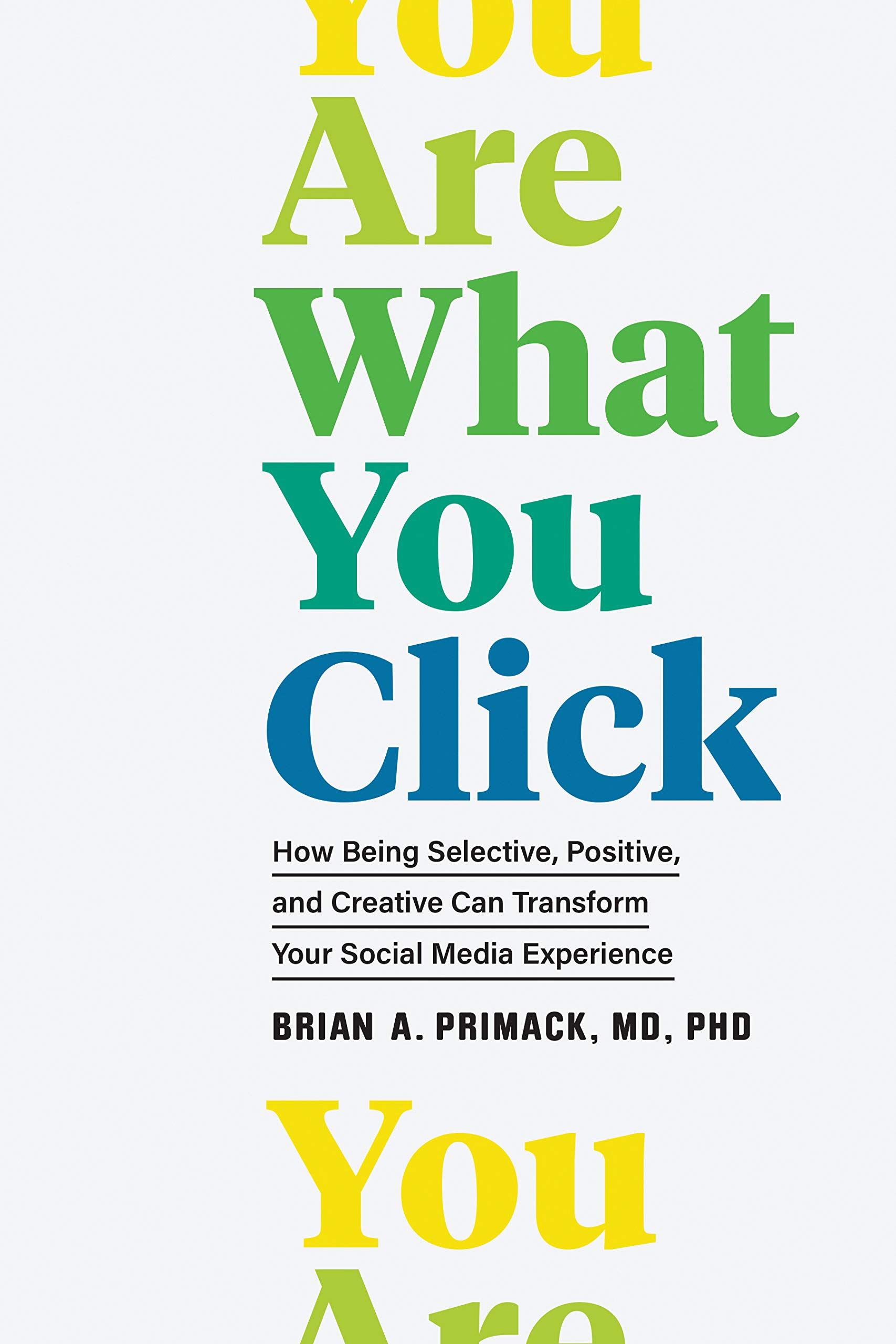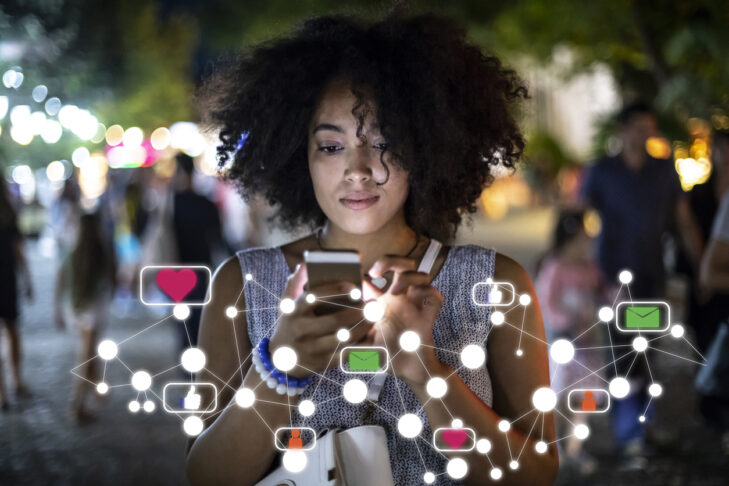Do you and your kids spend too much time on social media? Trolling pointless websites? Gazing dead-eyed at TikTok? Guilty.
Dr. Brian A. Primack, dean of the College of Education and Health Professions at the University of Arkansas, is an expert on how Americans are sucked in by social media and how it can affect people’s spirituality (for better or worse). His new book is called “You Are What You Click: How Being Selective, Positive, and Creative Can Transform Your Social Media Experience”—an ominous title for those of us who spend too much time clicking Instagram and Twitter and not enough on more enriching sites.
He talked with JewishBoston about social media, spirituality and how to improve our internet diet.
What are you trying to achieve with this book, especially at a time, thanks to the pandemic, when we’re all pretty isolated and stuck online a lot?

These are ideas I’ve been researching for a couple of decades, so before the pandemic—but there’s no question the pandemic has accelerated a lot of media use overall in both positive and negative ways. And I think that one way of summarizing the situation in the premise is just that social media, when it comes to mental health, is such a double-edged sword in our society. And especially now during COVID, it can bring warmth that can catalyze connection and generosity. On the other hand, it can breed feelings of depression, isolation and anxiety and worse. And so, I think that what I’ve been recognizing over the course of my career researching social media and mental health is that we need to advance this sort of double-edged sword by learning more about how best to live in balance, how to have a fruitful relationship with social media.
Is that possible? How do we winnow out the bad and maximize the good? It’s such a slippery slope.
For some individuals, they’re so sensitive to those challenges related to social media that maybe it’s not the best idea for that person. On the other hand, I think that for many people, we can get the positive to outweigh the negative, but I think it’s going to actually take some real work. It’s going to take some real thinking and some real nuance. So, for example, if you just eat whatever you feel like eating at the time, you’re probably not going to have a great diet. However, if you have thought about it carefully and said, “I want to have a certain number of fruits and vegetables, and I want to avoid this and I want to emphasize this,” then you can have a fine diet. That’s the analogy: You are what you click; you are what you eat. I think we need to go in a similar direction. We need to say that right now, as a society, we’re not doing great, we’re kind of just eating whatever we want, we’re just jumping onto all social media in a lot of ways. But if we do have a “food pyramid,” we can at least start the process.
What does that actually look like in practice? I’m coming from the angle of a parent who both is inundated with images of mom influencers on Instagram with their perfect babies and lives that seem not very realistic, and then I’m getting into the age where I have a kid who’s about to go into fifth grade—a tween about to embark on his own online journey.
This pyramid is different. It’s basically three layers, and the bottom layer is selectivity. It means thinking very, very carefully about what the benefit is going to be and to select that positive thing. Let’s say you and I both use social media about two hours a day, and we’re doing the same kinds of things on social media and we’re matched in every other way. The only thing that’s different between us is that you divide your two hours a day among two different platforms: Instagram, Reddit, Pinterest, whereas I use seven different platforms, because I want to keep up my Facebook and I want to keep up my Instagram and Twitter. It’s not that hard to get to seven, right?
So, what is the difference between you and me? Remember, we use the exact same two hours a day of social media, and people are always asking me, “How much time should I use?” And I usually say to them, “Well, how many platforms do you use?” And they’re looking unequivocally, like, “Why does that matter?” And the reason is that we found that the person who uses seven platforms as opposed to the person who uses two platforms is more than three times as likely to be depressed with the exact same amount of social media use in terms of the number of hours.
Why?
Each platform represents its own idiosyncratic world. So, if you’re focusing your attention on just two platforms, maybe you can get to know them better, maybe you’re more comfortable. As it is in real life, if you’re trying to be really good friends with seven different groups of people, it might leave you less satisfied. And so the bottom line is that we need to go through that active selection process.

We’re at a time when I think a lot of people are feeling vulnerable, and maybe a lot of us are doom-scrolling and feeling like we need to use seven different methods of intake because there’s so much going on in the world. How do you protect yourself and your kids from that vulnerability?
When people are feeling more vulnerable or more anxious or depressed, they turn to more social media, because it’s easier. We’re addicted to screens, and so it’s easy to just refresh, refresh, refresh. We all have them right in our pockets now, unlike even 30 years ago. It’s very easy to get wrapped into social media, but instead of that being adaptive, unfortunately, a lot of what happens can be maladaptive. Because that person who is depressed because they lost someone or because they went through a relationship fallout or tragedy is seeing all of these rosy images about positive relationships. The person who is retreating to social media because they’re very, very anxious about COVID is seeing the worst possible outcome from COVID in their feed. The person who had that get-rich-quick-scheme and lost all their money is now getting all of these advertisements for high-interest rate loans to do their next one.
The bottom line is that it’s so important to think when you’re vulnerable even more carefully about being selective, and then even more carefully about being positive, and then even more carefully about being creative, which are the other two levels of the pyramid. But our evolutionary biology has just not caught up yet. When it comes to social media use and increasing that, it can create an unfortunate vicious spiral that’s really not part of natural evolution.
How do you disentangle yourself or retrain yourself to have those more authentic connections, or those healthier connections?
It’s not easy. That’s why every chapter of the book is one bite-sized thing, because it really does take that conscious, nuanced effort. I’d love to say, “Just buy this tonic and just have a swig every morning!” I have chapters in the book that talk specifically about each of the different major personality types according to the “Big Five” personality indicator: conscientiousness, agreeableness, neuroticism, openness and extraversion. If you have those tendencies, what’s the best way to approach your own social media? I talk about sleep, how important sleep is, and some of our research on night-time use of social media as well as daytime use of social media, and how to really think about that for your specific individual situation.
I have a chapter on the Sabbath and how it led to the modern weekend. A lot of people are saying that we should have a social media Sabbath. Not everybody is Jewish and not everybody’s life revolves around this particular 24 hours, so are there other times that might be better for you as an individual or you as a family? These are complex decisions, unfortunately, but I really do think they’re doable if we chip away a little bit at a time, just like a good diet.
How can you use social media to foster Jewish spiritual growth? Social media gets a bad rap!
I think there are a lot of very positive uses of social media that are related to spirituality in general. Social media definitely helps people stay connected to family and friends who don’t live nearby. And in today’s world, we’re moving on average 12 times in our lifetime. We need that connection in a lot of ways, and that can be very spiritual. Social media can help people connect internationally, it can help connect people to other people in a very individual situation. For example, if somebody has a rare condition, and they don’t necessarily have people right up the street who also have history of psychosis X, they can connect with those people.
People also can be motivated by social media. We think a lot about the negative of social comparison, which we’ve already talked about. There’s no question that social comparison can make you feel bad about yourself and can make you feel unnecessarily like everybody else is having a great life except for me, because everybody is curating everything so specifically. However, think about this for a moment. Sometimes people will post a message and say, “Hey, I just started this exercise routine and it’s made me feel really good!” The flip side is that being exposed to others’ achievements can be motivating.
There’s also a lot of meaning on all of the GoFundMe pages, and all of the ways that you can find awareness for causes. All of the hashtags, Black Lives Matter, Love Wins, these are all things that really can help people find valuable spiritual connections. It’s just a question of realizing that there is a double-edged sword, and so we need to understand more how to sharpen those things and keep those things, but how to dull the other side.
You also talk about emojis, which is very pertinent to me as someone with two kids who like the poop one.
Chapter 29 is called “The Eloquence of Emoji.” An emoji is a microcosm of both the positive and the inadequacy of social media. Because when I see an emoji with something, it does change it for me. It does make me happy to see that little yellow thing with dots in a certain way. Right? And so I encourage people to use emojis and to think carefully about them, because they really are very expressive.
The Oxford English Dictionary every fall has the “Word of the Year.” In 2018, it was “toxic.” In 2013, it was “selfie.” In 2015, it was an emoji, for the first time ever! It was not a word; it was an image. It was the laughing while crying emoji, which is an incredibly expressive emoji, and I love that, and I use it. I really do encourage people to use those. That’s a tool you have. However, I just think it’s also important for people to realize that the human face has 43 different muscles. And so even if those muscles are just on or off, that means there are zillions, literally, of different expressions we can make. So, it’s just a reminder that it is good to use this replacement when we can. The gold standard for a relationship is still in-person, but we should use those tools when they are valuable and when we don’t have those other possibilities of the in-person relationship.
What do you hope people take away from your book?
What we need to really move forward positively is a set of balances and a set of nuances, and I just hope this starts the discussion so we aren’t throwing the baby out with the bath water, that we are using the tools that are around us. Every tool in history has had pros and cons associated with it. The printing press allowed people to spread propaganda, which led to hatred and problems more easily, but on the other hand we didn’t throw away the printing press. It also did a lot of good things. I think we need to be thinking along the same lines. We need to give this the same attention we give to food—because we are what we click, just like we are what we eat, and we need to really advance that discussion.



